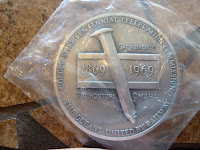In the second frame the boss is talking to a demon sitting at a control panel with lots of vacuum hoses leading this way and that. The machine labeled "Lifesuck 3000" and the boss is saying "They noticed."
I thought of that as I visited the expansive offices of "Slug Magazine" (click!) on Monday with Younger Son Ben, who is a senior writer for that publication.
He doesn't get paid, but he does get to go to concerts for free when he reviews them, and gets free books and DVDs, and he gets to see his writing published, so it's a fair deal.
The newsroom took me back to my early days in journalism -- newsrooms were never palatial or even very organized, but one thing they always were was open. Desks were set around here and there and all the reporters sat together, working away, talking to each other, sharing jokes and tips and stories and laughs and tears.
 I remember once, in the Standard-Examiner's old newsroom, hearing one of the reporters on the phone, crying because a friend/relative (I forget) was having an emergency, she was needed, but she was scheduled to work the night shift that night.
I remember once, in the Standard-Examiner's old newsroom, hearing one of the reporters on the phone, crying because a friend/relative (I forget) was having an emergency, she was needed, but she was scheduled to work the night shift that night.Three of us overheard her and said "Go, you're covered" before she could put the phone down.
That's the way it was. Everyone was family.
Slug's newsroom, which is very tiny (I suspect a lot of writers, like Ben, send their stuff in remotely) but is very open, very loose, decorated somewhat haphazardly. There's a bar (!) and a few desks set up next to each other. There's good light and windows. The couple of people we saw there working were having a good time chatting as they typed.
It is not possible to overstate how important this sort of arrangement is. Writers are creative people, and creative people feed off of each other. It pays to give them a good place to do that.
 The S-E, sadly, moved to BDO 13 years ago and took over a huge room full of leftover cubicles that the federal government had bought. They were tall, ugly, soul destroying. Reporters were spread around among pods. Bureaucratic divisions were enhanced by physical divisions. Windows? Only for a lucky few.
The S-E, sadly, moved to BDO 13 years ago and took over a huge room full of leftover cubicles that the federal government had bought. They were tall, ugly, soul destroying. Reporters were spread around among pods. Bureaucratic divisions were enhanced by physical divisions. Windows? Only for a lucky few.It was bad enough when there were 12 or 13 reporters working city desk, but as the number dropped the isolation got worse. Half a dozen people spread among four or five pods, all separated by 5-foot walls, is horrible.
The last two publishers, and probably the current one, felt the cubicles were a disaster, but nobody was willing to spend the money to replace them. I admit that my daily trip onto those faceless, nameless, bland and lonely corridors got harder and harder as the years went by and the numbers of other people got fewer and fewer. It felt as if I were trapped in some weird French art film, wandering empty hallways forever, seeking a way out.
Not saying cubicles were why I retired, but they didn't exactly send the message that I should stay. When Union Station dangled an office with a window, I jumped, and my kitchen table has lovely light as well. And flowers!
 More critically, cubicles destroy the dynamics of the newsroom -- there's no interaction, no community, no human togetherness. Yeah yeah, I know: The bosses say people can get up and go talk, but that having to get up is a barrier. People tend to turn their cubicles into personal caves and never look around. Why does management put up barriers to productivity?
More critically, cubicles destroy the dynamics of the newsroom -- there's no interaction, no community, no human togetherness. Yeah yeah, I know: The bosses say people can get up and go talk, but that having to get up is a barrier. People tend to turn their cubicles into personal caves and never look around. Why does management put up barriers to productivity?It won't solve all of the Standard-Examiner's problems, not by half, but if the new publisher wants to take a huge step in the direction of building a winning, productive news team, he'll bite the bullet and trash the cubicles.

















